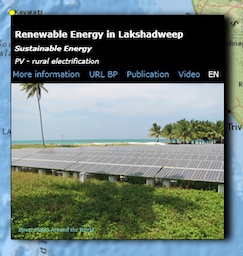Towards 100% RES.
 The Lakshadweep island group in the Arabian Sea is one of the two major groups of islands in India. It consists of an archipelago of 36 small sized coral islands and reefs scattered about 200-400 kilometers from the western coast of south India. Of these, 11 islands are inhabited. The main source of electricity was diesel generators, the diesel being transported from the mainland.
The Lakshadweep island group in the Arabian Sea is one of the two major groups of islands in India. It consists of an archipelago of 36 small sized coral islands and reefs scattered about 200-400 kilometers from the western coast of south India. Of these, 11 islands are inhabited. The main source of electricity was diesel generators, the diesel being transported from the mainland.
The islands present a different set of logistical problems where power generation is concerned due to their distance from the mainland. In this scenario, the extensive of solar power has provided a solution by which decentralized power can be generated near the users. This clean eco friendly power provides an ideal fit for the power needs as well as environmental considerations for these idyllic islands. The Lakshadweep Administration has now decided to extend the use of renewables in the islands, so that at least 20% of the total power demand is met by these alternate energy sources initially and then progress to 100% electrification through renewable energy.
Jointly funded by the Ministry of Non-Conventional Energy Sources, the Indian government and the Union Territory of Lakshadweep, the project would involve setting up the solar power plants on the islands of Agatti, Amini, Andrott, Chetlat, Kadmat, Kalpeni and Kavaratti.
Initially the smallest island Bitra was surveyed and a 5 kWp SPV Plant was set-up during 1988. Based on the successful operation, the same was augmented to 25 kWp in 1993, a 10 kWp SPV Power Plant was installed in 1996 at Bangaram Island and a 50 kWp SPV Power Plant in Kadmat Island during 1998.
These plants were stand alone SPV Power Plants, i.e. the power from the PV array was used to charge a battery bank and this power was converted to AC and used to power the loads at night. Apart from these power plants, solar PV street lighting systems have also been installed in the islands and solar lanterns have been distributed to individual houses. With advances in technology, Grid Interactive SPV Power plants which can be synchronized with the Diesel Grid on the islands has also introduced. As a demonstration project, with the financial assistance of Ministry of Non-Conventional Energy Sources, a 100 kWp Grid Interactive Solar Power Plant was installed at Kiltan island in the year 2000. Subsequently MNES sanctioned another 100 kWp Grid Interactive SPV Power Plant for Minicoy island which was also commissioned in the year 2000.
The successful operation of these SPV grid interactive plants emboldened the Department to embark on a major programme of providing electricity through Solar Power Plants to the various islands. Surveys were conducted in all the islands and proposal was submitted to MNES . During March 2001, the Ministry sanctioned an ambitious project of 700 kWp of SPV Power Plants.
This project envisages installation of 7 Nos. of 100 kWp SPV Power Plants in seven islands. The biomass plant will be treated as the base load plant and solar power plants will supplement it.
![]() Strategy plan for 100% RET utilization in Lakshadweep Island Energy Research Institute, ADEME, GENEC, 2001 PDF
Strategy plan for 100% RET utilization in Lakshadweep Island Energy Research Institute, ADEME, GENEC, 2001 PDF















